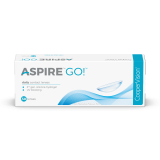
Lots of people have been told they have astigmatism, but not everyone knows what it really means. First of all, astigmatism is not a stigma, so it’s nothing to be ashamed of. Astigmatism is just a run-of-the-mill vision disorder, like nearsightedness (myopia) or farsightedness (hyperopia).
However, while myopia blurs distance vision and hyperopia blurs near vision, astigmatism blurs your vision at all distances. Traditionally, this has made it somewhat more challenging to address with contact lenses, but scientists have cracked the code, and opened up a whole new world of options to people who have astigmatism—including soft contact lenses that provide consistent clear and stable vision.
Understanding Astigmatism
Astigmatism refers to the shape or curvature of your eye’s cornea or lens. Ideally, your eye should be completely spherical. But if you have astigmatism, your eye is more oblong. This prevents light from focusing properly on your retina, causing your vision to blur whether you’re trying to see objects up close or far away.
Astigmatism can be present alongside other refractive errors, including myopia (near-sightedness) and hyperopia (far-sightedness).
How Do Contact Lenses Correct Astigmatism?
Imagine that the front surface of your eye looked like the face of a clock. For each pie-shaped slice of the clock, you have meridians. A special kind of contact lens, called a toric lens, work by applying different prescription lens powers to these different meridians to address your eye’s toroidal, or somewhat irregular shape.
The challenge that contact lens makers historically struggled with was how to keep the various optical powers of each meridian of the toric lens in the right place. If the lens moves around too much, you won’t be able to maintain clear and stable vision. Several strategies have been applied over the years with varying degrees of success.
More Options for Astigmatism
For many generations, the complexity of toric lens design limited contact lens options for people with astigmatism. In fact, many years ago, if you wanted to wear contact lenses for astigmatism, you would have to wear hard lenses, also known as “rigid gas permeable lenses.” But today there are several soft toric contact lenses in a wide range of prescriptions to fit all sorts of eyes.
Soft torics are also now available in a variety of materials and replacement schedules, including silicone hydrogel daily disposables. This is a remarkable leap in contact lens technology because while silicone hydrogel is the go-to material for frequent replacement lens wearers, until recent years, it wasn’t available in daily disposable brands. Furthermore, only recently did options open up further to include daily disposable silicone hydrogel torics. But despite the relative newness of these lenses in silicone hydrogel material, today 75% of eye care practitioners agree that all toric 1 day contact lenses wearers should be fit with toric silicone hydrogel 1 day lenses.1
Things are looking up for those who do have astigmatism and would like to wear soft contact lenses. If you have astigmatism and weren’t happy with your contact lens choices in the past, it may be time to reconsider. Call your doctor to find out.
1 ECP perception of the benefits of 1 day silicone hydrogels. February 2018. Cello Health Insight. Data on file. Survey carried out online in US, UK and Japan. Total sample size n=300 (100 ECPs in each country)






